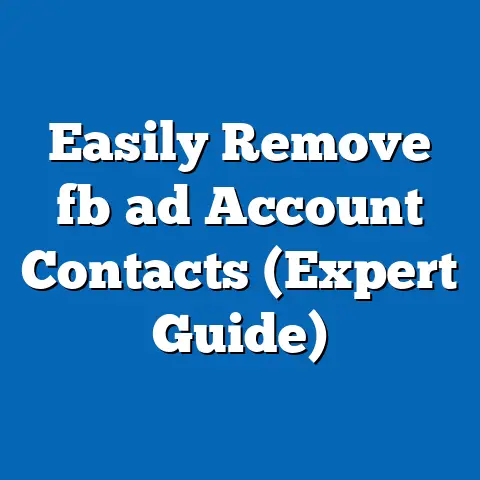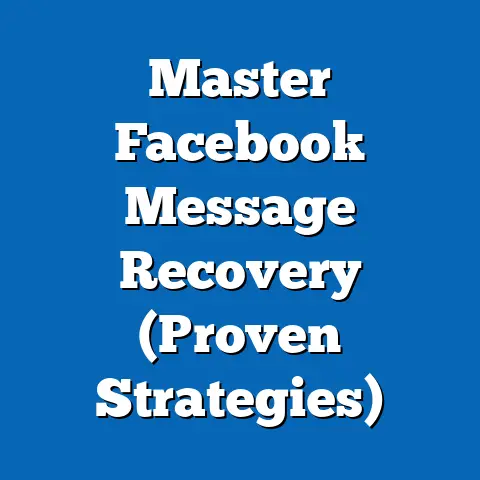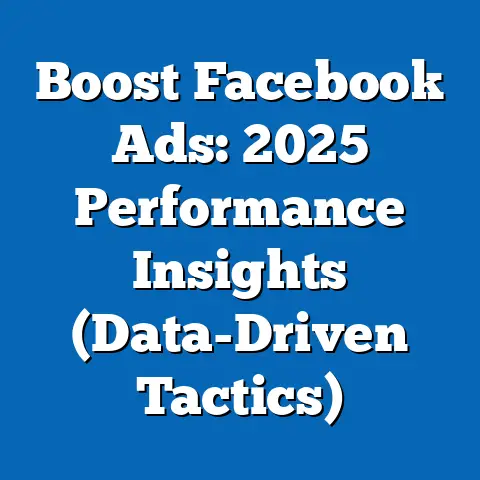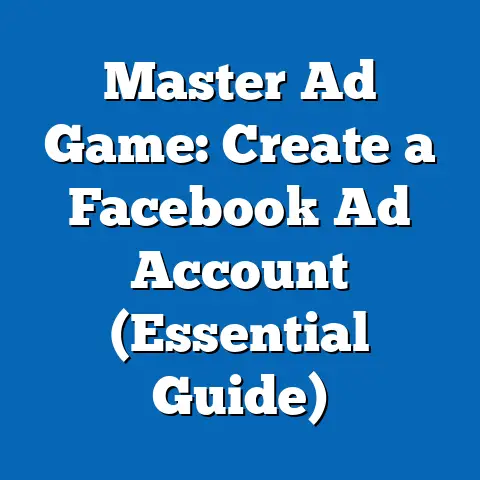Why Ad May Not Run on Facebook (Expert Solutions)
Understanding Facebook’s Advertising Ecosystem
Before we jump into the troubleshooting, let’s lay the foundation. Think of Facebook’s advertising ecosystem as a complex machine with many moving parts. If one part malfunctions, the whole system can grind to a halt.
Overview of Facebook Ads
Facebook ads are a powerful tool for reaching a massive audience – billions, in fact. They allow you to target specific demographics, interests, and behaviors, making them incredibly effective for reaching your ideal customer. The platform offers a variety of ad formats, from simple image ads to engaging video ads and interactive carousel ads.
The Role of Algorithms
Facebook’s algorithm is the gatekeeper to your audience. It determines which ads are shown to which users based on a complex set of factors, including:
- Bidding: How much you’re willing to pay for ad placement.
- Ad Quality: Facebook’s assessment of your ad’s relevance and engagement potential.
- Estimated Action Rates: The likelihood that users will take the desired action (e.g., click, purchase, lead generation).
- User Experience: Facebook prioritizes ads that provide a positive user experience.
The algorithm is constantly evolving, so what worked yesterday might not work today. Staying on top of these changes is essential for maintaining ad visibility and performance. I remember one time, I was running a campaign that was performing exceptionally well for a week. Suddenly, the reach plummeted. After some digging, I realized Facebook had tweaked its algorithm to favor video ads. I quickly adapted my strategy, and the campaign was back on track. This experience taught me the importance of being agile and responsive to changes in the Facebook landscape.
Common Objectives
Before launching a campaign, it’s crucial to define your objectives. Facebook offers a range of objectives, including:
- Brand Awareness: Increasing recognition and recall of your brand.
- Reach: Showing your ad to the maximum number of people.
- Traffic: Driving users to your website or landing page.
- Engagement: Encouraging likes, comments, shares, and other interactions.
- Lead Generation: Collecting contact information from potential customers.
- Conversions: Driving sales or other desired actions on your website.
Your objective directly influences how Facebook delivers your ads. For example, if your goal is conversions, Facebook will prioritize showing your ad to users who are most likely to make a purchase. Choosing the right objective is critical for maximizing the effectiveness of your campaign.
Takeaway: Understanding the Facebook advertising ecosystem, including the Ads Manager, algorithms, and objectives, is fundamental to troubleshooting why your ads might not be running.
Technical Reasons Why Ads May Not Run
Now, let’s get into the nitty-gritty. Technical issues are often the culprit behind ads not running. These can range from simple setup errors to more complex account problems.
Ad Review Process
Every ad you create goes through a review process before it’s approved to run. Facebook’s automated systems and human reviewers examine your ad to ensure it complies with their advertising policies. This process can take anywhere from a few minutes to 24 hours, or even longer in some cases.
Several factors can trigger an ad to be flagged for review:
- Suspicious Content: Ads containing potentially misleading or harmful information.
- Policy Violations: Ads that violate Facebook’s advertising policies (more on this later).
- New Accounts: New ad accounts often face stricter scrutiny.
- Significant Changes: Making substantial changes to an existing ad can trigger a new review.
If your ad is flagged, you’ll receive a notification in the Ads Manager. It’s essential to carefully review the reason for the rejection and make the necessary corrections.
Violations of Advertising Policies
Facebook’s advertising policies are extensive and can be tricky to navigate. Violating these policies is one of the most common reasons why ads are rejected. Here are some common violations to watch out for:
- Prohibited Content: Ads promoting illegal products or services, discrimination, or violence.
- Misleading Claims: Ads making false or exaggerated claims about products or services.
- Inappropriate Imagery: Ads containing sexually suggestive or violent imagery.
- Personal Attributes: Ads that directly address or imply personal attributes like race, religion, or sexual orientation.
- Health and Medical Claims: Ads making unsubstantiated health or medical claims.
I once worked with a client who was running ads for a weight loss product. Their initial ads were rejected because they made exaggerated claims about the product’s effectiveness. We revised the ad copy to focus on the product’s ingredients and benefits without making any specific weight loss claims, and the ads were subsequently approved. This experience highlighted the importance of being truthful and transparent in your advertising.
Account Issues
Problems with your ad account can also prevent your ads from running. These issues can include:
- Account Suspension: Facebook may suspend your account if you repeatedly violate their advertising policies.
- Billing Problems: Issues with your payment method or outstanding balances can prevent ads from running.
- Payment Method Issues: Expired or invalid credit cards, or insufficient funds, can also cause problems.
- Spending Limits: Setting overly restrictive spending limits can prevent your ads from reaching their full potential.
If your account is suspended, you’ll need to contact Facebook support to resolve the issue. Make sure your payment information is up-to-date and that you’re not exceeding your spending limits.
Targeting Restrictions
Incorrect or overly restrictive targeting settings can also prevent your ads from running effectively. Consider these potential issues:
- Narrow Audiences: Targeting too narrow an audience can limit your reach and prevent your ads from being shown.
- Demographic Restrictions: Certain demographics may be restricted based on Facebook’s policies.
- Interest Targeting: Using irrelevant or overly specific interests can limit your reach.
- Location Targeting: Incorrect location targeting can prevent your ads from being shown in the right areas.
I once ran a campaign targeting a very niche audience with specific interests. The reach was incredibly low, and the ads barely ran. After expanding the audience and using broader interest targeting, the campaign’s reach increased significantly, and the ads started performing much better. This taught me the importance of striking a balance between specificity and reach when defining your target audience.
Takeaway: Technical issues, such as policy violations, account problems, and targeting restrictions, are common reasons why ads may not run. Carefully review your ad settings and account status to identify and resolve these issues.
Creative Factors Affecting Ad Approval
It’s not just the technical aspects that matter. The creative elements of your ad – the images, videos, and ad copy – also play a crucial role in whether your ad is approved and performs well.
Image and Video Quality
High-quality visuals are essential for capturing attention and driving engagement. Poor image or video quality can lead to ad rejection or, even if the ad is approved, poor performance. Keep these guidelines in mind:
- Resolution: Use high-resolution images and videos that are clear and crisp.
- Aspect Ratio: Ensure your visuals are optimized for the specific ad placement.
- Relevance: Use visuals that are relevant to your product or service and target audience.
- Originality: Avoid using stock photos that are overused or generic.
I’ve seen countless ads with blurry or pixelated images. These ads not only look unprofessional but also fail to capture the viewer’s attention. Investing in high-quality visuals is crucial for creating effective and engaging ads.
Ad Copy Compliance
The language you use in your ad copy can also impact approval. Avoid using:
- Excessive Capitalization: Using ALL CAPS can be seen as aggressive and spammy.
- Sensationalism: Exaggerated or misleading claims can lead to ad rejection.
- Grammatical Errors: Poor grammar and spelling can make your ad look unprofessional.
- Clickbait: Using misleading or sensational headlines to entice clicks.
Your ad copy should be clear, concise, and truthful. Focus on highlighting the benefits of your product or service and using a tone that resonates with your target audience.
Landing Page Issues
Your landing page is where users are directed after clicking on your ad. Issues with your landing page can negatively impact ad performance and even lead to ad rejection. Ensure your landing page:
- Loads Quickly: Slow loading times can frustrate users and lead to high bounce rates.
- Is Mobile-Friendly: Ensure your landing page is optimized for mobile devices.
- Is Relevant: The content on your landing page should be relevant to the ad that the user clicked on.
- Complies with Policies: Your landing page should comply with Facebook’s advertising policies.
I’ve seen many campaigns fail because the landing page was poorly designed or didn’t deliver on the promises made in the ad. Make sure your landing page provides a seamless and relevant experience for users who click on your ad.
Takeaway: The creative elements of your ad, including image and video quality, ad copy compliance, and landing page quality, are crucial for ad approval and performance. Ensure your ads are visually appealing, truthful, and relevant to your target audience.
Market and Audience Considerations
Sometimes, even if your ad is technically sound and creatively appealing, it might still struggle to run effectively due to market and audience factors.
Audience Saturation
Audience saturation occurs when your target audience has been repeatedly exposed to your ads or similar ads. This can lead to ad fatigue, where users become less responsive to your ads.
Signs of audience saturation include:
- Decreasing Click-Through Rates (CTR): Fewer users are clicking on your ads.
- Increasing Cost Per Click (CPC): You’re paying more for each click.
- Decreasing Conversion Rates: Fewer users are taking the desired action on your landing page.
To combat audience saturation, try:
- Refreshing Your Creative: Update your images, videos, and ad copy.
- Expanding Your Targeting: Explore new audiences or interests.
- Using Lookalike Audiences: Create audiences that are similar to your existing customers.
- Adjusting Your Bidding Strategy: Experiment with different bidding strategies to optimize your ad spend.
Seasonal Trends
Seasonal trends and changes in consumer behavior can also impact ad performance. For example, ads for winter clothing are likely to perform better in the fall and winter months.
Consider these factors when planning your campaigns:
- Holidays: Plan your campaigns around major holidays and seasonal events.
- Weather: Adjust your messaging and creative based on the weather in your target location.
- Economic Conditions: Be mindful of economic conditions and adjust your messaging accordingly.
- Cultural Events: Consider cultural events and festivals that may impact consumer behavior.
Competitor Activity
Increased competition in your niche can also lead to your ads being overshadowed or not shown as frequently. If your competitors are running similar ads and targeting the same audience, you may need to:
- Increase Your Bids: Pay more to outbid your competitors.
- Differentiate Your Messaging: Highlight what makes your product or service unique.
- Refine Your Targeting: Find a niche audience that your competitors are overlooking.
- Improve Your Ad Quality: Create higher-quality ads that are more engaging and relevant.
Takeaway: Market and audience factors, such as audience saturation, seasonal trends, and competitor activity, can impact ad performance. Be mindful of these factors and adjust your strategies accordingly.
Expert Solutions to Common Ad Issues
Okay, we’ve covered the potential problems. Now, let’s get to the solutions. Here are some expert tips for resolving common ad issues and getting your campaigns back on track.
Ensuring Compliance
Compliance with Facebook’s advertising policies is paramount. Here are some tips for ensuring your ads comply:
- Read the Policies: Familiarize yourself with Facebook’s advertising policies and guidelines.
- Review Your Ads: Carefully review your ads before submitting them for approval.
- Use the Ad Preview Tool: Use the Ad Preview tool to see how your ad will look on different devices and placements.
- Seek Legal Advice: If you’re unsure about whether your ad complies with Facebook’s policies, seek legal advice.
- Regular Audits: Conduct regular audits of your ad content to ensure ongoing compliance.
I always recommend creating a checklist of Facebook’s advertising policies and using it to review each ad before launching it. This can help you catch potential violations and avoid ad rejections.
Ad Optimization Strategies
Optimizing your ads is crucial for improving performance and maximizing ROI. Here are some strategies to consider:
- A/B Testing: Test different versions of your ad to see which performs best.
- Refining Targeting: Continuously refine your targeting to reach the most relevant audience.
- Enhancing Creative Assets: Invest in high-quality images, videos, and ad copy.
- Adjusting Bidding Strategies: Experiment with different bidding strategies to optimize your ad spend.
- Monitoring Performance: Continuously monitor your ad performance and make adjustments as needed.
A/B testing is one of the most powerful tools for optimizing your ads. By testing different headlines, images, and calls to action, you can identify what resonates best with your target audience.
Leveraging Facebook Support
Facebook’s support team can be a valuable resource for resolving ad issues. Here are some tips for effectively communicating with them:
- Be Clear and Concise: Clearly explain the issue you’re experiencing.
- Provide Details: Provide as much detail as possible, including ad IDs, account IDs, and screenshots.
- Be Patient: Response times can vary, so be patient and persistent.
- Escalate if Necessary: If you’re not getting the help you need, escalate the issue to a higher level.
I’ve found that being polite and professional when communicating with Facebook support can go a long way. Remember, they’re there to help you, but they’re also dealing with a high volume of inquiries.
Keeping Up with Changes
Facebook’s advertising policies and algorithms are constantly evolving. Staying informed about these changes is essential for maintaining ad visibility and performance. Here are some ways to stay up-to-date:
- Follow Facebook’s Blog: Subscribe to Facebook’s official blog for updates on new features and policies.
- Join Industry Forums: Participate in online forums and communities to learn from other marketers.
- Attend Webinars: Attend webinars and conferences to stay informed about the latest trends.
- Experiment Continuously: Continuously experiment with new strategies and techniques to see what works best.
Takeaway: Expert solutions to common ad issues include ensuring compliance, optimizing your ads, leveraging Facebook support, and staying up-to-date with changes.
Case Studies and Real-World Examples
Let’s bring this all together with some real-world examples. I’m going to share some case studies of businesses that faced ad rejection and successfully resolved the issues through expert solutions.
Successful Resolutions
-
Case Study 1: E-commerce Business
- Problem: Ads were rejected for making misleading claims about product effectiveness.
- Solution: Revised ad copy to focus on product features and benefits without making specific claims.
- Result: Ads were approved, and the business saw a significant increase in sales.
-
Case Study 2: Local Restaurant
- Problem: Ads were performing poorly due to audience saturation.
- Solution: Refreshed the creative assets and used lookalike audiences.
- Result: Ad performance improved, and the company saw an increase in lead generation.
Case Study 1: E-commerce Business
- Problem: Ads were rejected for making misleading claims about product effectiveness.
- Solution: Revised ad copy to focus on product features and benefits without making specific claims.
- Result: Ads were approved, and the business saw a significant increase in sales.
Case Study 2: Local Restaurant
- Problem: Ads were performing poorly due to audience saturation.
- Solution: Refreshed the creative assets and used lookalike audiences.
- Result: Ad performance improved, and the company saw an increase in lead generation.
Lessons Learned
These case studies highlight several key lessons:
- Compliance is Key: Always prioritize compliance with Facebook’s advertising policies.
- Optimization is Crucial: Continuously optimize your ads to improve performance.
- Flexibility is Essential: Be prepared to adapt your strategies based on market conditions and audience behavior.
- Data-Driven Decisions: Use data to inform your decisions and track your progress.
Takeaway: Case studies and real-world examples demonstrate the importance of compliance, optimization, flexibility, and data-driven decision-making in Facebook advertising.
The key takeaways are:
- Understand the Facebook Advertising Ecosystem: Know how the Ads Manager, algorithms, and objectives work together.
- Prioritize Compliance: Always adhere to Facebook’s advertising policies.
- Optimize Continuously: Continuously test and refine your ads to improve performance.
- Stay Informed: Keep up-to-date with changes in Facebook’s policies and algorithms.
- Leverage Facebook Support: Don’t hesitate to reach out to Facebook support for help.
Now, it’s time to put these strategies into action. Review your ad campaigns, identify any potential issues, and implement the solutions we’ve discussed. With a little bit of effort and a lot of perseverance, you can get your Facebook ads running and delivering the results you’re looking for.
Don’t just read this guide – use it! Implement these strategies, track your progress, and adapt your approach as needed. The world of Facebook advertising is constantly evolving, so continuous learning and experimentation are essential for success.
I encourage you to take the first step today. Start by reviewing your ad campaigns and identifying any potential issues. Then, implement the solutions we’ve discussed and track your progress. With a little bit of effort, you can transform your Facebook advertising from a source of frustration into a powerful tool for achieving your business goals. Good luck!






